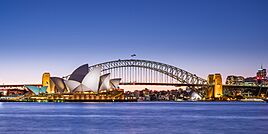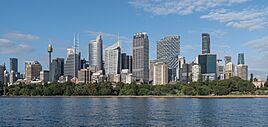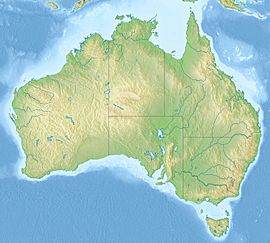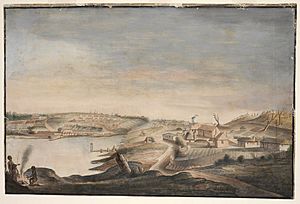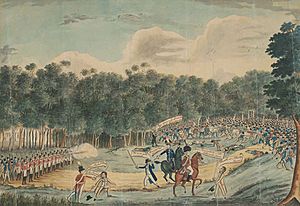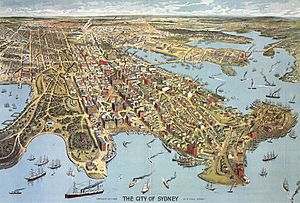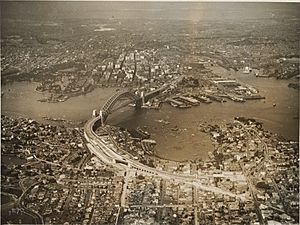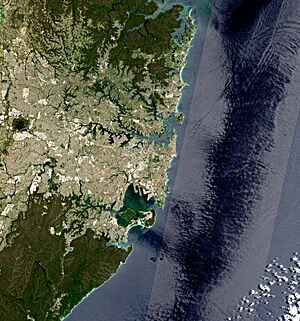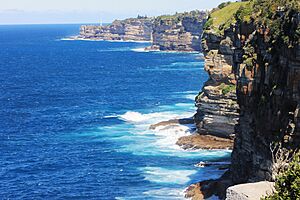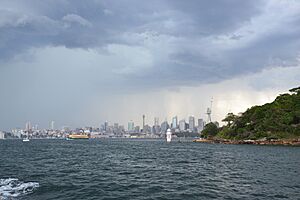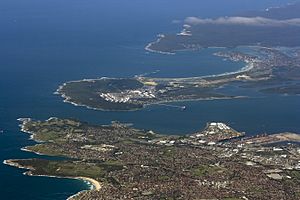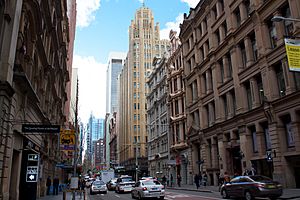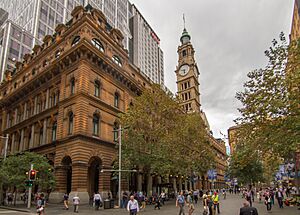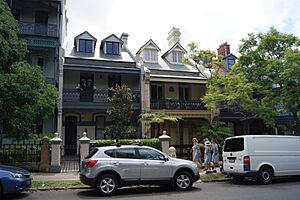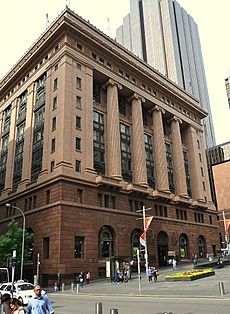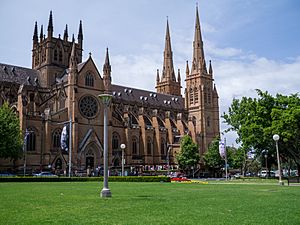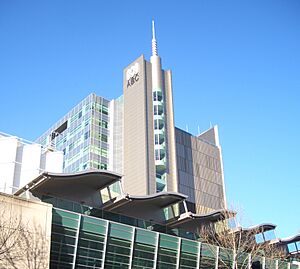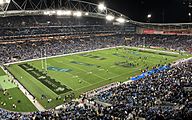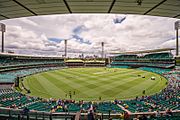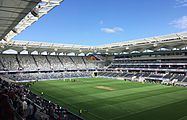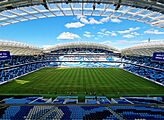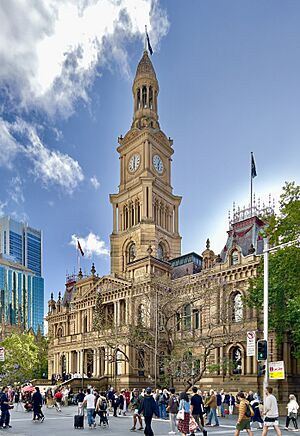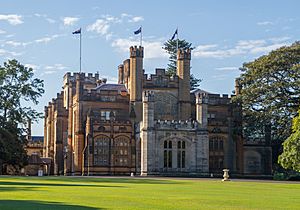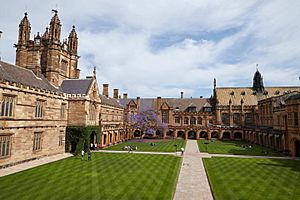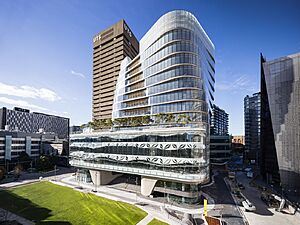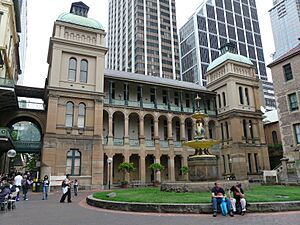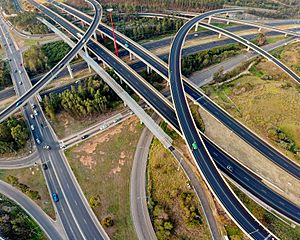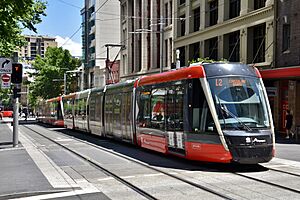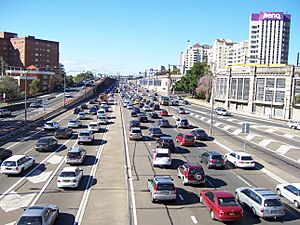Sydney facts for kids
Quick facts for kids SydneyNew South Wales |
|||||||||
|---|---|---|---|---|---|---|---|---|---|
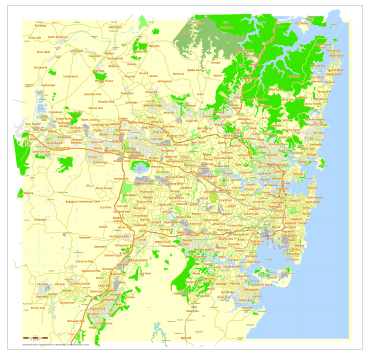
Map of the Sydney metropolitan area
|
|||||||||
| Population | 5,557,233 (2024) (1st) | ||||||||
| • Density | 441/km2 (1,140/sq mi) (2023) | ||||||||
| Established | 26 January 1788 | ||||||||
| Area | 12,367.7 km2 (4,775.2 sq mi)(GCCSA) | ||||||||
| Time zone | AEST (UTC+10) | ||||||||
| • Summer (DST) | AEDT (UTC+11) | ||||||||
| Location | |||||||||
| LGA(s) | Various (33) | ||||||||
| County | Cumberland | ||||||||
| State electorate(s) | Various (49) | ||||||||
| Federal Division(s) | Various (24) | ||||||||
|
|||||||||
Sydney is the capital city of New South Wales, a state in Australia. It is the largest city in Australia by population. Sydney is located on Australia's east coast, surrounding Sydney Harbour. The city stretches about 80 kilometers (50 miles) from the Pacific Ocean in the east to the Blue Mountains in the west.
Sydney is also known as the Emerald City and the Harbour City. About 5.5 million people live here, which is around 66% of New South Wales' population. People who live in Sydney are often called "Sydneysiders".
Long ago, Aboriginal Australians lived in the Sydney area for at least 30,000 years. You can still find their ancient rock carvings and cultural sites. The traditional owners of this land are the Darug, Dharawal, and Eora clans.
In 1770, James Cook explored Australia's eastern coast and landed at Botany Bay. Later, in 1788, the First Fleet arrived. This group of ships, led by Arthur Phillip, started Sydney as a British settlement. It was the first European settlement in Australia.
After World War II, many people from other countries moved to Sydney. By 2021, over 40% of the people living in Sydney were born overseas. Many came from China, India, the United Kingdom, Vietnam, and the Philippines.
Sydney is known as one of the most expensive cities in the world. However, it often ranks among the top ten most livable cities. It's considered an "Alpha+ city" by the Globalization and World Cities Research Network. This means it's a very important city for business and culture around the world.
Sydney has a strong economy with strengths in education, finance, and tourism. The University of Sydney and the University of New South Wales are two of the top universities globally.
The city has hosted big international sports events. These include the 2000 Summer Olympics, the 2003 Rugby World Cup Final, and the 2023 FIFA Women's World Cup Final. Millions of tourists visit Sydney every year to see famous places.
Sydney has over 1 million hectares (2.5 million acres) of nature reserves and parks. Important natural features include Sydney Harbour and Royal National Park. The Sydney Harbour Bridge and the Sydney Opera House are major attractions. The Opera House is even a World Heritage Site.
Central Station is a main hub for Sydney's trains and light rail. Kingsford Smith Airport is the city's main passenger airport. It is one of the oldest airports that is still used today.
Contents
About Sydney's Name
In 1788, Captain Arthur Phillip was the first governor of New South Wales. He named the first British settlement Sydney Cove after Thomas Townshend, 1st Viscount Sydney. He was the Home Secretary at the time. The Aboriginal people called this cove Warrane.
Phillip thought about naming the settlement Albion, but this name was never officially used. By 1790, people were regularly calling the town Sydney. Sydney officially became a city in 1842.
The Gadigal clan lived on the land where the British first settled. Their territory stretched along the southern shore of Port Jackson. They called their land Gadi (Cadi). Aboriginal clan names often ended with "-gal". This suffix meant "people from" a certain territory or place. Greater Sydney covers the traditional lands of 28 known Aboriginal clans.
Sydney's History
First People of the Sydney Region
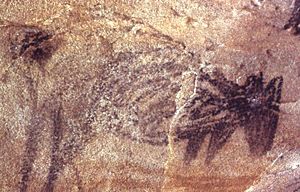
The first people in the Sydney area were Aboriginal Australians. They came from Southeast Asia. Stone tools found in Western Sydney suggest people lived here 45,000 to 50,000 years ago. Other evidence shows human activity from about 30,000 years ago. Before the British arrived, there were between 4,000 and 8,000 Aboriginal people in the greater Sydney region.
These people fished, hunted, and gathered plants and shellfish for food. Coastal clans ate more seafood. Clans living inland ate more forest animals and plants. They used tools and weapons made from stone, wood, plants, bone, and shells.
Aboriginal clans had rich ceremonies. These were part of their belief system about ancestors and spirits. People from different clans would gather for ceremonies. These events also helped with trade, marriages, and alliances between groups.
Early British settlers recorded the word 'Eora'. It was an Aboriginal term meaning "people" or "from this place". The clans in the Sydney area had traditional land boundaries. The main groups were the coastal Eora people. The Dharug (Darug) lived inland from Parramatta to the Blue Mountains. The Dharawal people lived south of Botany Bay.
The first meeting between Aboriginal people and British explorers happened on April 29, 1770. Lieutenant James Cook landed at Botany Bay (Kamay). He met the Gweagal clan. Cook and his crew stayed for a week. They collected water, timber, and plants. Cook tried to build relationships with the Aboriginal people, but it was not successful.
Sydney as a Colony (1788–1840)
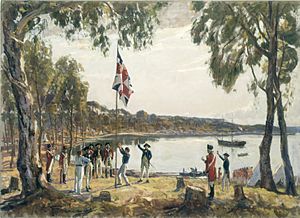
Britain had sent prisoners to its American colonies for many years. After losing these colonies in 1783, Britain decided to start a new prison colony in Australia. They also saw it as a good location for a new naval base.
The First Fleet of 11 ships arrived in Botany Bay in January 1788. Captain Arthur Phillip led the fleet. It had over a thousand settlers, including 736 prisoners. The fleet soon moved to Port Jackson. A settlement was started at Sydney Cove on January 26, 1788. Governor Phillip officially declared the colony of New South Wales on February 7, 1788. Sydney Cove had fresh water and a safe harbor. Phillip called it "the finest Harbour in the World."
The colony was meant to grow its own food. Trade and shipbuilding were not allowed to keep the prisoners isolated. But the soil was poor, and the first crops failed. This led to years of hunger. The food shortage ended when the Second Fleet arrived in 1790 and the Third Fleet in 1791. Former prisoners received small pieces of land. Farms spread to more fertile areas around Parramatta, Windsor, and Camden. By 1804, the colony could feed itself.
A smallpox outbreak in April 1789 killed about half of the local Indigenous population. In November 1790, Bennelong led a group of Sydney clan survivors into the settlement. This kept Aboriginal Australians present in Sydney.
Governor Phillip had a plan for the new town in July 1788. It included wide streets and public buildings. However, he ignored his own plan, and the town grew without much order.
After Phillip left in 1792, military officers started buying land. They also imported goods from ships. Former prisoners started trading and opening small businesses. Soldiers and former prisoners built houses on government land.
Governor Lachlan Macquarie (1810–1821) greatly helped Sydney grow. He started a bank, a currency, and a hospital. He hired a planner for Sydney's streets. He also ordered the building of roads, wharves, churches, and public buildings. A road to Parramatta opened in 1811. A road across the Blue Mountains was finished in 1815. This opened up land for farming west of the Great Dividing Range.
More free British settlers came to New South Wales. Immigration increased from 900 in 1826–30 to 29,000 in 1836–40. Many settled in Sydney. By the 1840s, Sydney had rich and poor areas. Free settlers and former prisoners made up most of the population. They pushed for more self-governance. Sending prisoners to New South Wales stopped in 1840.
Conflicts on the Cumberland Plain
In 1804, Irish prisoners led about 300 rebels in the Castle Hill Rebellion. They tried to march on Sydney to take a ship and escape. They were poorly armed. Their leader, Philip Cunningham, was captured. About 100 troops defeated the rebels at Rouse Hill. At least 39 prisoners died in the uprising.
As the colony grew towards the Hawkesbury River, conflicts with the Darug people increased. This peaked from 1794 to 1810. Darug groups, led by Pemulwuy and later his son Tedbury, burned crops and raided settler stores. This resistance continued as the colony expanded. A military base was set up on the Hawkesbury in 1795. Between 1794 and 1800, 26 settlers and up to 200 Darug people died.
Another conflict happened from 1814 to 1816. The colony expanded into Dharawal land southwest of Sydney. After some settlers died, Governor Macquarie sent soldiers into Dharawal lands. This led to the Appin Massacre in April 1816, where at least 14 Aboriginal people were killed.
Sydney as a Colonial City (1841–1900)
New South Wales got a partly elected government in 1842. Sydney was declared a city that same year. A city council was formed, elected by property owners.
The discovery of gold in New South Wales and Victoria in 1851 first caused problems. Many men left for the goldfields. Melbourne soon became Australia's largest city, leading to a rivalry with Sydney. However, more people came from overseas. Wealth from gold exports increased demand for homes, goods, and services. The government also invested in railways, trams, roads, and schools. Sydney's population grew from 95,600 in 1861 to 386,900 in 1891.
The city developed many of its famous features. People lived in rows of terrace houses on narrow streets. Many new public buildings were made of sandstone. These included the University of Sydney (1854–61) and the Australian Museum (1858–66).
A drought and a financial crisis led to an economic downturn in Sydney during the 1890s.
Sydney as a State Capital (1901–Present)
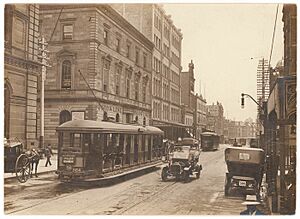
On January 1, 1901, the six Australian colonies joined together. Sydney became the capital of New South Wales. A bubonic plague outbreak in 1900 led the government to improve the wharves and clear inner-city slums.
When First World War started in 1914, many Sydney men volunteered for the armed forces. This helped reduce unemployment. After the war in 1918, returning soldiers were promised "homes fit for heroes" in new suburbs. Sydney's population reached one million in 1926. The government created jobs with big projects. These included electrifying the Sydney rail network and building the Sydney Harbour Bridge.
The Great Depression of the 1930s hit Sydney harder than other areas. New building almost stopped. By 1933, unemployment for men was 28%. In working-class areas, it was over 40%. Many families lost their homes. Shanty towns grew along the coast.
In January 1938, Sydney celebrated the Empire Games. It also marked 150 years since European settlement. A journalist described Sydney's "Golden beaches. Sun tanned men and maidens...Red-roofed villas terraced above the blue waters of the harbour..." However, Aboriginal leaders declared January 26 a "Day of Mourning" for the loss of their land.
When Second World War began in 1939, Sydney's industries grew. Unemployment disappeared. Women took jobs usually done by men. Japanese submarines attacked Sydney Harbour in May and June 1942, killing 21 people. People built air raid shelters and practiced drills. Military defenses were built around Sydney Harbour.
After the war, many immigrants arrived. There was also a baby boom. Sydney's population grew quickly. Low-density housing spread across the Cumberland Plain. Most immigrants came from Britain and Europe. They and their children made up over three-quarters of Sydney's population growth between 1947 and 1971. Manufacturing was a major employer. But as the economy grew, retail and service industries became the main source of new jobs.
In 1954, about one million people watched Queen Elizabeth II arrive at Farm Cove. This was where Captain Phillip had first raised the British flag. It was the first time a reigning monarch visited Australia.
More high-rise buildings were built. Suburbs expanded beyond planned "green belts". This led to protests. In the early 1970s, unions and community groups stopped development projects in historic areas like The Rocks. Governments introduced laws to protect heritage and the environment. The Sydney Opera House was also controversial because of its cost. But after it opened in 1973, it became a major tourist attraction and a symbol of the city.
From the 1980s, overseas immigration grew fast. Asia, the Middle East, and Africa became major sources. By 2021, Sydney's population was over 5.2 million. 40% of the people were born overseas. China and India became the largest source countries for overseas-born residents.
Sydney's Geography
Sydney's Landscape
Sydney is in a coastal basin. The Tasman Sea is to the east. The Blue Mountains are to the west. The Hawkesbury River is to the north. The Woronora Plateau is to the south.
Sydney covers two main areas. The Cumberland Plain is south and west of the Harbour. It is quite flat. The Hornsby Plateau is to the north. It has steep valleys. The flat areas were developed first. The northern parts became more populated after the Sydney Harbour Bridge was built. Sydney has 70 surf beaches along its coast. Bondi Beach is the most famous.
The Nepean River flows around the western edge of the city. It becomes the Hawkesbury River before reaching Broken Bay. Most of Sydney's water storage dams are on rivers that flow into the Nepean River. The Parramatta River is mostly industrial. It drains a large area of Sydney's western suburbs into Port Jackson. The southern parts of the city are drained by the Georges River and the Cooks River into Botany Bay.
The area called Greater Sydney covers about 12,369 square kilometers (4,776 square miles). It includes areas like Central Coast in the north and Blue Mountains in the west. The City of Sydney local government area is much smaller, about 26 square kilometers (10 square miles). It covers the city center and nearby suburbs.
Sydney's Geology
Sydney's rocks are mostly from the Triassic period. There are also some newer igneous rocks. The Sydney Basin formed in the early Triassic period. The sand that became today's sandstone was laid down between 360 and 200 million years ago. This sandstone has layers of shale and old riverbeds.
The continental shelf of Australia is only about 25.9 kilometers (16.1 miles) from Sydney's coast. That is where the deep Tasman Abyssal Plain is.
The Sydney Basin has coastal features like cliffs, beaches, and estuaries. Deep river valleys, called rias, were carved during the Triassic period. As sea levels rose between 18,000 and 6,000 years ago, these valleys filled with water. This formed estuaries and deep harbors. Port Jackson, or Sydney Harbour, is one of these rias.
Sydney has two main soil types. Sandy soils come from the Hawkesbury sandstone. Clay soils come from shales and volcanic rocks. Some soils are a mix of both.
Above the Hawkesbury sandstone is the Wianamatta shale. This is found in western Sydney. It formed from a large river delta during the Middle Triassic period. The Wianamatta shale is mostly fine-grained rocks like shales and mudstones.
Sydney's Nature
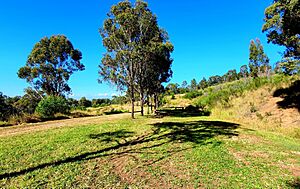
The most common plants in Sydney are grassy woodlands (like savannas). There are also some dry sclerophyll forests. These forests have eucalyptus trees, casuarinas, and melaleucas. They also have shrubs like wattles and banksias, with grass underneath. These plants often have rough, spiky leaves because the soil is not very rich. Sydney also has some wet sclerophyll forests in wetter, higher areas in the north and northeast. These forests have tall trees and a moist understory of soft-leaved shrubs and tree ferns.
The main plant communities in Sydney are the Cumberland Plain Woodland in Western Sydney. Also, the Sydney Turpentine-Ironbark Forest in the Inner West and Northern Sydney. The Eastern Suburbs Banksia Scrub is along the coast. The Blue Gum High Forest is found in the North Shore. All of these are critically endangered. The city also has the Sydney Sandstone Ridgetop Woodland in Ku-ring-gai Chase National Park to the north.
Sydney is home to many bird species. Common ones include the Australian raven, Australian magpie, and crested pigeon. Some introduced birds found everywhere are the common myna and common starling. There are also many reptile species, mostly skinks. Sydney has some mammal and spider species, like the grey-headed flying fox and the Sydney funnel-web. Its harbor and beaches have a huge variety of marine species.
Sydney's Climate
Sydney has a humid subtropical climate. This means it has warm, sometimes hot, summers and generally mild winters. Weather patterns are affected by the El Niño–Southern Oscillation, the Indian Ocean Dipole, and the Southern Annular Mode. These can bring drought and bushfires or storms and flooding. The ocean helps keep temperatures moderate. Inland western suburbs have more extreme temperatures.
At Observatory Hill, temperatures have ranged from 45.8°C (114.4°F) in January 2013 to 2.1°C (35.8°F) in June 1932. The city center has temperatures of 30°C (86°F) or higher about 15 days a year. In the wider metropolitan area, this happens 35 to 65 days a year. The hottest day in the metropolitan area was 48.9°C (120.0°F) in Penrith in January 2020. The average sea temperature is 18.5°C (65.3°F) in September and 23.7°C (74.7°F) in February. Sydney gets about 7.2 hours of sunshine daily.
Sydney experiences an urban heat island effect. This means some parts of the city get hotter. In late spring and summer, temperatures over 35°C (95°F) are common. Hot, dry conditions often end with a "southerly buster." This is a strong southerly wind that brings a quick drop in temperature.
Rainfall is usually spread throughout the year. But recently, it has been more common in summer and more unpredictable. Rainfall is generally higher from summer to autumn. It is lower in late winter to early spring. In late autumn and winter, east coast lows can bring a lot of rain. In the warm season, "black nor'easters" often cause heavy rain. 'Snow' was last reported in 1836, but it was likely soft hail. In July 2008, the Upper North Shore saw soft hail that many thought was snow. In 2009, dry conditions caused a severe dust storm in the city.
| Climate data for Sydney | |||||||||||||
|---|---|---|---|---|---|---|---|---|---|---|---|---|---|
| Month | Jan | Feb | Mar | Apr | May | Jun | Jul | Aug | Sep | Oct | Nov | Dec | Year |
| Record high °C (°F) | 45.3 (113.5) |
42.1 (107.8) |
39.8 (103.6) |
33.9 (93.0) |
30.0 (86.0) |
26.9 (80.4) |
25.9 (78.6) |
31.3 (88.3) |
34.6 (94.3) |
38.2 (100.8) |
41.8 (107.2) |
42.2 (108.0) |
45.3 (113.5) |
| Mean daily maximum °C (°F) | 25.9 (78.6) |
25.8 (78.4) |
24.7 (76.5) |
22.4 (72.3) |
19.4 (66.9) |
16.9 (62.4) |
16.3 (61.3) |
17.8 (64.0) |
20.0 (68.0) |
22.1 (71.8) |
23.6 (74.5) |
25.2 (77.4) |
21.7 (71.1) |
| Mean daily minimum °C (°F) | 18.7 (65.7) |
18.8 (65.8) |
17.5 (63.5) |
14.7 (58.5) |
11.5 (52.7) |
9.3 (48.7) |
8.0 (46.4) |
8.9 (48.0) |
11.1 (52.0) |
13.5 (56.3) |
15.6 (60.1) |
17.5 (63.5) |
13.8 (56.8) |
| Record low °C (°F) | 10.6 (51.1) |
9.6 (49.3) |
9.3 (48.7) |
7.0 (44.6) |
4.4 (39.9) |
2.1 (35.8) |
2.2 (36.0) |
2.7 (36.9) |
4.9 (40.8) |
5.7 (42.3) |
7.7 (45.9) |
9.1 (48.4) |
2.1 (35.8) |
| Average rainfall mm (inches) | 101.5 (4.00) |
118.7 (4.67) |
128.9 (5.07) |
125.8 (4.95) |
121.1 (4.77) |
130.7 (5.15) |
97.3 (3.83) |
81.2 (3.20) |
69.1 (2.72) |
77.6 (3.06) |
83.1 (3.27) |
77.8 (3.06) |
1,212.8 (47.75) |
| Average rainy days (≥ of ANY volume) | 12.2 | 12.4 | 13.5 | 12.8 | 13.2 | 12.5 | 11.1 | 10.5 | 10.6 | 11.6 | 11.6 | 11.5 | 143.5 |
| Mean monthly sunshine hours | 220.1 | 194.3 | 198.4 | 192.0 | 182.9 | 165.0 | 198.4 | 220.1 | 216.0 | 223.2 | 234.0 | 235.6 | 2,480 |
| Source: Bureau of Meteorology | |||||||||||||
Sydney's Regions
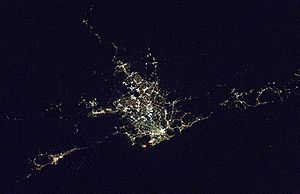
The Greater Sydney Commission divides Sydney into three "cities" and five "districts." These are based on the 33 local government areas. The "metropolis of three cities" includes Eastern Harbour City, Central River City, and Western Parkland City. The Australian Bureau of Statistics also includes the City of Central Coast as part of Greater Sydney.
Inner Suburbs
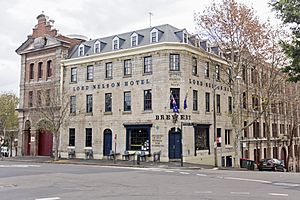
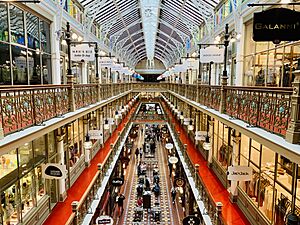
The CBD is about 3 kilometers (1.9 miles) south from Sydney Cove. It is next to Farm Cove and the Royal Botanic Garden to the east. Darling Harbour is to the west. Suburbs around the CBD include Woolloomooloo and Potts Point to the east. Surry Hills and Darlinghurst are to the south. Pyrmont and Ultimo are to the west. Millers Point and The Rocks are to the north. Most of these suburbs are small. Sydney's CBD has narrow streets from its early days.
Several important areas exist within Sydney's inner parts. Central and Circular Quay are major transport hubs. They have ferries, trains, and buses. Chinatown, Darling Harbour, and Kings Cross are popular for culture, tourism, and fun. The Strand Arcade is a historic Victorian-style shopping arcade. It opened in 1892. Westfield Sydney, under the Sydney Tower, is the largest shopping center in Sydney.
Since the late 1900s, many inner suburbs have been improved. Pyrmont, on the harbor, changed from a shipping area to a place with many homes and tourist spots. Darlinghurst, once outside the city, has also been greatly improved since the 1980s.
Green Square is an old industrial area in Waterloo. It is being redeveloped. On the harbor, the historic area of Millers Point is becoming the new area of Barangaroo. Paddington is known for its restored terrace houses and shopping.
Inner West
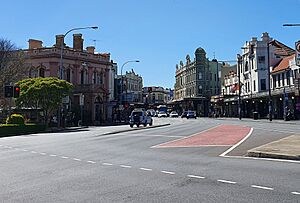
The Inner West includes areas like the Inner West Council and Municipality of Strathfield. These areas are about 11 kilometers (6.8 miles) west of the CBD. In the past, outer Inner West suburbs like Strathfield had large country estates for rich families. Inner suburbs were closer to transport and industry. They housed working-class people. These areas have been improved since the late 1900s. Many parts are now very valuable places to live.
The University of Sydney is in this area. So are the University of Technology, Sydney and a campus of the Australian Catholic University. The Anzac Bridge connects Rozelle to Pyrmont and the city.
The Inner West is known for its diverse village centers. Examples include "Little Italy" in Leichhardt and "Little Korea" in Strathfield. Large shopping centers include Westfield Burwood and DFO Homebush. King Street, Newtown has a lively community and nightlife.
The area has train services on the Sydney Trains' T1 and T2 lines. The L1 light rail line also runs through the area. Strathfield railway station is a major train hub. The future Sydney Metro West will connect this area to the City and Parramatta. Ferries, buses, and cycleways also serve the area.
Eastern Suburbs
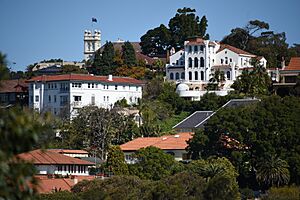
The Eastern Suburbs include areas like the Municipality of Woollahra and the City of Randwick. These areas have some of the wealthiest neighborhoods in Australia. Some streets are among the most expensive globally. For example, Wolseley Road, Point Piper, had a top price of $20,900 per square meter in 2014.
Major landmarks include Bondi Beach, which is on the Australian National Heritage List. Bondi Junction has a Westfield shopping center and a train station. The suburb of Randwick has Randwick Racecourse and several hospitals. The University of New South Wales Kensington Campus is also there.
The CBD and South East Light Rail was finished in April 2020. It provides reliable tram services to the City and South-East. Major shopping centers in the area are Westfield Bondi Junction and Westfield Eastgardens.
Southern Sydney
The Southern district of Sydney includes suburbs in the Georges River Council and the Sutherland Shire. These are on the southern banks of the Georges River.
The Kurnell peninsula, near Botany Bay, is where James Cook first landed in 1770. La Perouse is a historic suburb. It is named after the French explorer Jean-François de Galaup, comte de Lapérouse. It has an old military outpost at Bare Island and the Botany Bay National Park.
The suburb of Cronulla is close to Royal National Park. This is Australia's oldest national park. Hurstville is a large suburb with many commercial and high-rise buildings. It has become a main center for the southern suburbs.
Northern Sydney
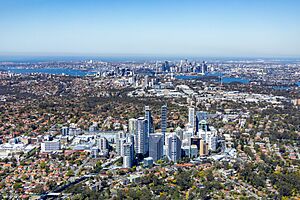
'Northern Sydney' includes suburbs in the Upper North Shore, Lower North Shore, and the Northern Beaches.
The Northern Suburbs have several landmarks. These include Macquarie University, Gladesville Bridge, and Macquarie Centre. This area includes suburbs in the Hornsby Shire, Ku-ring-gai Council, and City of Ryde.
The North Shore has commercial centers like North Sydney and Chatswood. North Sydney has many high-rise buildings, second only to the CBD. It is a hub for advertising and marketing companies.
The Northern Beaches area includes Manly. This is a popular holiday spot in Sydney. The region also has Sydney Heads, which are headlands forming the entrance to Sydney Harbour. The Northern Beaches area extends south to Sydney Harbour and north to Broken Bay.
Hills District
The Hills district refers to suburbs in north-western Sydney. This includes areas like The Hills Shire. The region is named for its hilly landscape. Windsor and Old Windsor Roads are some of the oldest roads in Australia.
On May 26, 2019, the Sydney Metro Northwest opened. It runs from Chatswood to Tallawong. This was the first time the Hills District had heavy rail. Before this, the Hills area used Bus Rapid Transit.
Western Suburbs
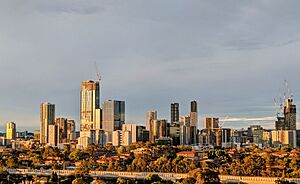
The greater western suburbs include Parramatta, which is Australia's sixth largest business district. Other areas are Bankstown, Liverpool, Penrith, and Fairfield. Western Sydney covers about 5,800 square kilometers (2,200 square miles). It has a population of over 2.2 million people.
Western Sydney has many different cultures. Cabramatta is known as "Little Saigon" because of its Vietnamese population. Fairfield is called "Little Assyria" for its Assyrian population. Harris Park is known as "Little India" due to its large Indian and Hindu community. Most people in this area are working class. They work in industries and trades.
Prospect is home to Raging Waters, a water park. The Auburn Botanic Gardens attract many visitors. The greater west also includes Sydney Olympic Park, built for the 2000 Summer Olympics. Sydney Motorsport Park is a circuit in Eastern Creek. Prospect Hill is a historic ridge. It is the only area in Sydney with ancient volcanic activity.
To the northwest, Featherdale Wildlife Park is a zoo in Doonside. Sydney Zoo, opened in 2019, is another zoo in Bungaribee. The Old Government House in Parramatta was built in 1799. It is a historic house museum and tourist spot. It is Australia's oldest surviving public building.
Further southwest is the region of Macarthur and the city of Campbelltown. Macarthur Square is a large shopping complex in Campbelltown. The southwest also has Bankstown Reservoir. This is the oldest elevated reservoir made of reinforced concrete that is still used. The Bland Oak in Carramar is one of Sydney's oldest trees. It was planted in the 1840s.
Sydney's Buildings and Spaces
Sydney's Architecture
The first buildings in the colony were very basic. Governor Macquarie wanted better designs for new projects. Today, Sydney has buildings listed as World Heritage and National Heritage sites. These show that Macquarie's ideas lasted.
In 1814, the Governor asked a prisoner named Francis Greenway to design Macquarie Lighthouse. Its Classical design earned Greenway a pardon in 1818. This started a tradition of refined architecture. Greenway also designed the Hyde Park Barracks in 1819. He designed the Georgian style St James's Church in 1824.
Gothic-inspired architecture became popular from the 1830s. John Verge's Elizabeth Bay House and St Philip's Church (1856) were built in Gothic Revival style. So was Edward Blore's Government House (1845). Kirribilli House (1858) and St Andrew's Cathedral are rare examples of Victorian Gothic style.
From the late 1850s, there was a shift to Classical architecture. Mortimer Lewis designed the Australian Museum in 1857. The General Post Office, finished in 1891, was designed by James Barnet. Barnet also oversaw the rebuilding of Greenway's Macquarie Lighthouse in 1883. Customs House was built in 1844. The Town Hall was completed in 1889.
Romanesque designs became popular from the early 1890s. Sydney Technical College was finished in 1893. The Queen Victoria Building was designed in Romanesque Revival style by George McRae. It was completed in 1898 and has 200 shops.
As Sydney grew after 1901, its buildings became taller. Sydney's first tower was Culwulla Chambers, which was 50 meters (160 feet) tall with 12 floors. The Commercial Traveller's Club, built in 1908, was similar. Height limits were lifted in the 1960s, leading to many new high-rise buildings.
The Great Depression affected Sydney's architecture. New buildings were simpler. The most famous building from this time is the Harbour Bridge. Its steel arch was designed by John Bradfield and finished in 1932. It spans 503 meters (1,650 feet).
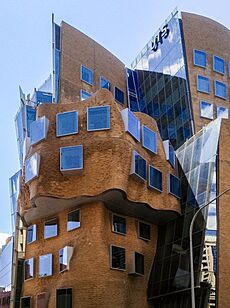
Modern and International architecture came to Sydney from the 1940s. The Sydney Opera House, finished in 1973, is a World Heritage Site. It is one of the world's most famous modern designs. Jørn Utzon won an award for his work on the Opera House. Sydney is also home to Australia's first building by architect Frank Gehry, the Dr Chau Chak Wing Building (2015).
Modern buildings in the CBD include Citigroup Centre and Chifley Tower. The tallest structure is Sydney Tower, finished in 1981. Due to Sydney Airport, there is a maximum height limit of 330 meters (1,083 feet). Laws have been in place since 1977 to protect Sydney's historic buildings.
Sydney's Housing
Sydney has some of the most expensive real estate in the world. It is Australia's most expensive housing market. The average house price was $1,595,310 in December 2023.
In 2021, Sydney had 1.83 million homes. About 900,000 (54%) were detached houses. 218,000 (13%) were semi-detached terrace houses. 550,000 (33%) were units and apartments. Terrace houses are common in inner-city areas. Detached houses are more common in outer suburbs. There has been a trend towards more apartments. The number of apartments increased by 30% between 1996 and 2006.
Public housing in Sydney is managed by the Government of New South Wales. Suburbs with many public housing areas include Claymore and Mount Druitt.
Many different styles of historic homes can be found in Sydney. Terrace houses are in inner suburbs like Paddington and The Rocks. These were once home to miners and laborers. Today, they are some of the most valuable homes. Large mansions from the Victorian era are in older suburbs like Double Bay and Rose Bay.
Federation homes were built around 1901. They are in suburbs that grew with the railways, like Penshurst. Workers' cottages are in Surry Hills and Balmain. California bungalows are common in Ashfield. Larger modern homes are mostly in outer suburbs.
Parks and Green Spaces

The Anzac War Memorial in Hyde Park honors Australian soldiers from World War I.
The Royal Botanic Garden is a famous green space. It is used for science and recreation. The City of Sydney manages 15 separate parks. Parks in the city center include Hyde Park and The Domain.
The Centennial Parklands is the largest park in the City of Sydney. It covers 189 hectares (470 acres).
Outer suburbs have Sydney Park and Royal National Park in the south. Ku-ring-gai Chase National Park is in the north. Western Sydney Parklands in the west is one of the largest urban parks in the world. The Royal National Park was created in 1879. It is the second oldest national park globally.
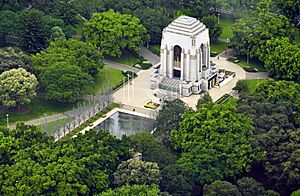
Hyde Park is the oldest public parkland in Australia. It covers 16.2 hectares (40 acres). It was used for relaxation and grazing animals from the colony's early days. Governor Macquarie dedicated it in 1810 for the "recreation and amusement of the inhabitants."
The area now called The Domain was Governor Arthur Phillip's private reserve in 1788. The land north of The Domain became the Royal Botanic Garden in 1816. This makes them the oldest botanic garden in Australia. The Gardens do scientific research. The two parks cover 64 hectares (160 acres) and have 8,900 plant species. They get over 3.5 million visitors each year.
Sydney's Economy
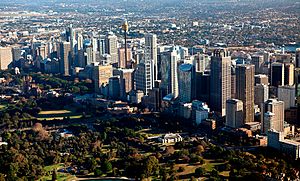
Sydney is one of the top ten world cities in the global economy. The Global Economic Power Index ranks Sydney eleventh in the world. The Global Cities Index ranks it fourteenth for global involvement. Many foreign banks and large companies are in Sydney. It is known as Australia's financial capital. It is also a leading financial hub in the Asia–Pacific region.
In early colonial times, the economy was based on mercantilism. It struggled at first because farming was hard. Governor Macquarie created new coins to help. By the 1840s, the economy was more capitalist. More free settlers arrived. The shipping and wool industries grew.
Wheat, gold, and other minerals became important exports in the late 1800s. A lot of money came into the city. This helped build roads, railways, bridges, and schools. After Australia joined together in 1901, policies helped create a manufacturing industry. This became the city's largest employer by the 1920s. These policies also helped during the Great Depression. Unemployment in New South Wales reached 32%. From the 1960s, Parramatta became known as Sydney's second CBD. Finance and tourism became major industries.
Sydney's economy was worth AU$400.9 billion in 2015. This was AU$80,000 per person. It was the largest economy in Australia. The financial and insurance services industry makes up 18.1% of the economy. Professional services make up 9%, and manufacturing 7.2%. The creative and technology sectors are also important.
Businesses in Sydney
In 2011, Sydney had 451,000 businesses. This included 48% of Australia's top 500 companies. Two-thirds of the regional headquarters for international companies are in Sydney. Global companies like Sydney because its time zone allows business with both North America and Europe. Most foreign companies in Sydney focus on sales and service. There are 283 international companies with regional offices in Sydney.
Sydney's Financial Services
In 1817, Macquarie allowed the first bank in Australia to form, the Bank of New South Wales. More private banks opened in the 1800s. But the financial system was not stable. Many banks failed in 1893.
The Bank of New South Wales is now Westpac. The Commonwealth Bank of Australia started in Sydney in 1911. It began to issue money. The Reserve Bank of Australia, also in Sydney, took over this role in 1959. The Australian Securities Exchange started in 1987. It is now one of the ten largest stock exchanges in the world.
The Financial and Insurance Services industry makes up 43% of the City of Sydney's economy. Sydney is half of Australia's finance sector. It is promoted as the leading financial center in the Asia–Pacific region. In 2017, Sydney was ranked the eighth most competitive financial center globally.
In 1985, the government allowed 16 foreign banks to operate. Now, 40 of the 43 foreign banks in Australia are based in Sydney. These include the People's Bank of China and Bank of America.
Manufacturing in Sydney
Sydney has been a manufacturing city since the 1920s. By 1961, this industry provided 39% of all jobs. By 1970, over 30% of all Australian manufacturing jobs were in Sydney. Its importance has decreased in recent years. It made up 12.6% of jobs in 2001 and 8.5% in 2011. Between 1970 and 1985, 180,000 manufacturing jobs were lost.
Despite this, Sydney became the largest manufacturing center in Australia in the 2010s. Its manufacturing output was $21.7 billion in 2013. Sydney's focus on local markets and high-tech manufacturing helped it stay strong. The Smithfield-Wetherill Park Industrial Estate in Western Sydney is the largest industrial area in the Southern Hemisphere. It is a center for manufacturing and distribution.
Tourism and Education

Sydney is a main entry point to Australia for many international visitors. It is among the top sixty most visited cities globally. In 2013, it hosted over 2.8 million international visitors. These visitors spent 59 million nights in the city and a total of $5.9 billion. Most visitors came from China, New Zealand, and the United Kingdom.
The city also had 8.3 million domestic visitors in 2013. They spent $6 billion. In 2011, 26,700 people in the City of Sydney worked directly in tourism. On average, tourism adds $36 million to the city's economy every day.
Popular places to visit include the Sydney Opera House and the Sydney Harbour Bridge. Other spots are Watsons Bay, The Rocks, Sydney Tower, Darling Harbour, and the Royal Botanic Garden. Museums like the Australian Museum and the Museum of Contemporary Art are also popular. Bondi Beach, Luna Park, and Sydney Olympic Park are also big attractions.
Major projects to boost tourism include a casino and hotel at Barangaroo. Also, the redevelopment of East Darling Harbour includes a new exhibition and convention center. This is now Australia's largest.
Sydney is the top city in the world for international students. Over 50,000 international students study at its universities. Another 50,000 study at its vocational and English language schools. International education adds $1.6 billion to the local economy. It also creates 4,000 local jobs each year.
Housing Costs
In 2023, Sydney was ranked the least affordable city to buy a house in Australia. It was the second least affordable city in the world, after Hong Kong. The average Sydney house price in late 2023 was A$1.59 million. The average unit price was A$795,000. As of early 2024, media often describes Sydney as having a housing shortage.
Sydney's People
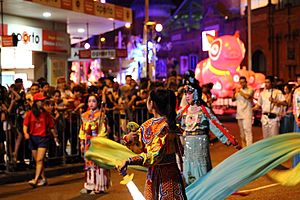
In 1788, Sydney's population was less than 1,000. With prisoners arriving, it almost tripled in ten years to 2,953. Since 1961, the population has grown by over 250,000 every decade. The 2021 census showed Greater Sydney's population was 5,231,150. The Australian Treasury expects it to reach 6.5 million by 2033–34. Sydney has the four most crowded suburbs in Australia. Each has over 13,000 residents per square kilometer.
The average age of Sydney residents is 37. About 14.8% of people are 65 or older. 48.6% of Sydney's population is married. 36.7% have never been married. 49.0% of families are couples with children. 34.4% are couples without children. 14.8% are single-parent families.
Ancestry and Immigration
At the 2021 census, the most common ancestries were:
- English (21.8%)
- Australian (20.4%)
- Chinese (11.6%)
- Irish (7.2%)
- Scottish (5.6%)
- Indian (4.9%)
- Italian (4.3%)
- Lebanese (3.5%)
- Filipino (2.7%)
- Greek (2.6%)
- Vietnamese (2.5%)
- German (2.2%)
- Korean (1.4%)
- Nepalese (1.4%)
- Australian Aboriginal (1.4%)
- Maltese (1.1%)
In 2021, 40.5% of Sydney's population was born overseas. The most common birthplaces were mainland China, India, England, Vietnam, Philippines, and New Zealand.
At the 2021 census, 1.7% of Sydney's population identified as Indigenous. This includes Aboriginal Australians and Torres Strait Islanders.
Languages Spoken
In Sydney, 42% of households use a language other than English. The most common non-English languages are Mandarin (5%), Arabic (4.2%), Cantonese (2.8%), Vietnamese (2.2%), and Hindi (1.5%).
Religions in Sydney
In 2021, Christianity was the largest religion at 46%. The biggest Christian groups were Catholicism (23.1%) and Anglicanism (9.2%). 30.3% of Sydney residents said they had no religion.
The most common non-Christian religions were Islam (6.3%), Hinduism (4.8%), Buddhism (3.8%), Sikhism (0.7%), and Judaism (0.7%). About 500 people identified with traditional Aboriginal religions.
The Church of England was the only recognized church until 1820. Governor Macquarie then appointed official Catholic chaplains. Macquarie also ordered the building of churches like St Matthew's and St James's. Religious groups have played a big role in education, health, and charity in Sydney's history.
Safety in Sydney
Sydney is a very safe city. The Independent ranked Sydney as the fifth safest city in the world in 2019.
Sydney's Culture
Science, Art, and History
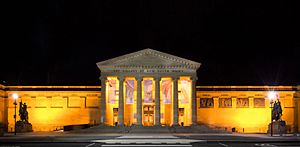
Ku-ring-gai Chase National Park has a rich Indigenous Australian heritage. It contains about 1,500 pieces of Aboriginal rock art. This is the largest group of Indigenous sites in Australia. These sites include rock carvings, cave drawings, and burial sites. They are thought to be around 5,000 years old. The Garigal people lived in this area. Other rock art sites are in Sydney, but their locations are often kept private. This helps protect them from damage.
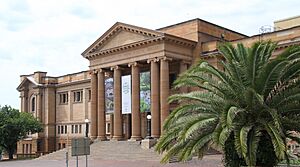
The Australian Museum opened in Sydney in 1827. Its goal was to collect and show the natural treasures of the colony. It is Australia's oldest natural history museum. In 1995, the Museum of Sydney opened. It tells the story of the city's growth. Other museums include the Powerhouse Museum and the Australian National Maritime Museum.
The State Library of New South Wales has Australia's oldest library collections. It started in 1826. The Royal Society of New South Wales, formed in 1866, promotes science, art, and literature. The Sydney Observatory building was built in 1859. It was used for astronomy research until 1982. Now it is a museum.
The Museum of Contemporary Art opened in 1991. It is in an Art Deco building in Circular Quay. The Art Gallery of New South Wales is another important art place. It organizes the Archibald Prize for portraits. Sydney also has Artspace, a contemporary art gallery.
Entertainment in Sydney
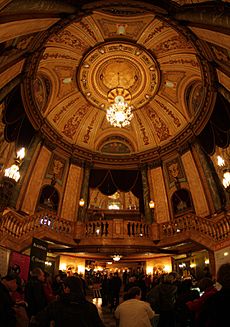
Sydney's first commercial theater opened in 1832. By the late 1920s, nine more had opened. Live theater became less popular during the Great Depression because of movies. But it became popular again after World War II. Important theaters today include State Theatre, Theatre Royal, and Capitol Theatre. The Sydney Theatre Company performs local and international plays.
The Sydney Opera House is home to Opera Australia and Sydney Symphony. It has hosted over 100,000 performances. It has had 100 million visitors since opening in 1973. Other important places for performances are Town Hall and the City Recital Hall. The Sydney Conservatorium of Music is next to the Royal Botanic Garden.

Many writers have come from Sydney or set their stories there. Some are honored on the Sydney Writers Walk at Circular Quay. Sydney had Australia's first newspaper, the Sydney Gazette. Early books about Sydney often focused on life in the city's working-class areas. Famous modern novels set in Sydney include Melina Marchetta's Looking for Alibrandi (1992). The Sydney Writers' Festival is held every year.
Filmmaking was big in Sydney until the 1920s. Then, movies with sound became popular, and American films took over. The Australian New Wave brought a rise in film production. Many famous movies were shot in Sydney in the 1970s and 80s. Fox Studios Australia started making films in Sydney in 1998. Successful films shot here include The Matrix and Moulin Rouge!. The National Institute of Dramatic Art is in Sydney. Many famous actors have studied there.
Sydney hosts several festivals each year. The city's New Year's Eve celebrations are the biggest in Australia. The Royal Easter Show is held every year at Sydney Olympic Park. Sydney Festival is Australia's largest arts festival. Vivid Sydney is an annual outdoor show of art, light, and music. Sydney also hosts the Australian Fashion Week. The Sydney Mardi Gras has been held every February since 1979.
Sydney's Chinatown has moved locations over the years. It is now on Dixon Street. "Little Italy" is on Stanley Street.
Restaurants, bars, and nightclubs are in entertainment areas. These include the Sydney CBD, Oxford Street, Surry Hills, Newtown, and Parramatta. The Star is the city's casino. The new Crown Sydney resort is in Barangaroo.
Media in Sydney
The Sydney Morning Herald is Australia's oldest newspaper still printed. It has been published since 1831. Its competitor is The Daily Telegraph, printed since 1879. Both have Sunday editions. The Bulletin started in Sydney in 1880. It was Australia's longest-running magazine.
Australia's three commercial TV networks and two public broadcasters are based in Sydney. Nine's offices are in North Sydney. Ten is in Pyrmont. Seven is in South Eveleigh. The Australian Broadcasting Corporation is in Ultimo. The Special Broadcasting Service is in Artarmon. Foxtel is in North Ryde.
Sydney's first radio stations started broadcasting in the 1920s. Radio has continued to be popular. 2UE was founded in 1925. It is the oldest station still broadcasting. Other stations include 2GB, ABC Radio Sydney, and KIIS 106.5.
Sports and Outdoor Activities
Sydney's early settlers loved sports. But they had few facilities. The first organized sports were boxing, wrestling, and horse racing. These started in 1810 in Hyde Park. Horse racing is still popular. Events like the Golden Slipper Stakes attract many people.
The first cricket club formed in 1826. Cricket is a favorite summer sport. Big matches have been held at the Sydney Cricket Ground since 1878. The New South Wales Blues play in the Sheffield Shield league. The Sydney Sixers and Sydney Thunder play in the national Big Bash competition.
Rugby started in Sydney in 1865. It became the city's most popular football game by the 1880s. Rugby league separated from rugby union in 1908. The New South Wales Waratahs play in the Super Rugby competition. The national Wallabies rugby union team plays international matches in Sydney. Sydney has nine teams in the National Rugby League competition.
Sydney FC and the Western Sydney Wanderers play in the A-League Men and A-League Women competitions. The Sydney Swans and Greater Western Sydney Giants are local Australian rules football clubs. The Sydney Kings play in the National Basketball League. The Sydney Blue Sox play in the Australian Baseball League.
Major Sporting Venues
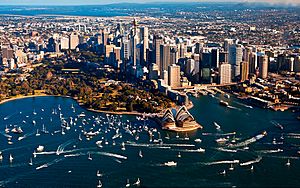
Women were first allowed to swim for fun in the 1830s. Sea bathing became very popular in the early 1900s. The first surf lifesaving club started at Bondi Beach. The City2Surf is an annual 14-kilometer (8.7-mile) running race. It goes from the CBD to Bondi Beach. In 2010, 80,000 runners took part.
Sailing races have been held on Sydney Harbour since 1827. Yachting has been popular since the 1840s. The Sydney to Hobart Yacht Race is a 1,170-kilometer (727-mile) event. It starts from Sydney Harbour on Boxing Day. It is known as one of the hardest yacht races in the world.
The Royal Sydney Golf Club is in Rose Bay. It has hosted the Australian Open 13 times. Royal Randwick Racecourse opened in 1833. It holds several major horse races.
Sydney built many sports facilities for the 2000 Summer Olympics. Sydney Olympic Park has facilities for athletics, swimming, tennis, and more. It also has Stadium Australia, used for rugby, soccer, and Australian rules football. The Sydney Football Stadium was finished in 1988. Sydney Cricket Ground opened in 1878.
Sydney was one of the host cities for the 2023 FIFA Women's World Cup. Sydney Football Stadium and Stadium Australia were used. Stadium Australia hosted the final.
The Sydney International tennis tournament is held each year. It is a warm-up for the Australian Open in Melbourne. Two famous tennis players, Ken Rosewall and Todd Woodbridge, were born in Sydney.
Sydney's Government
Past Governance
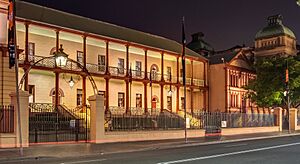
The first five governors of New South Wales had almost complete power. Sydney was the government seat for the colony. The first Legislative Council met in 1826. In 1842, the council was expanded and partly elected. That same year, Sydney officially became a city. An elected city council was formed. It had limited powers, mostly for services like street lighting. Its area was small, covering the city center and some inner suburbs. As Sydney grew, other local councils were formed.
In 1856, New South Wales gained self-government. It got a two-house parliament based in Sydney. This included an elected Legislative Assembly. When the Australian colonies joined together in 1901, Sydney became the capital of New South Wales. Its government was split between the national, state, and local levels.
Present Government
Like other Australian capital cities, Sydney does not have one single local government for its whole area. Local government areas handle things like local roads, libraries, and waste collection. The state government is responsible for main roads, public transport, and education. There are 33 local government areas mostly within Greater Sydney.
- Bayside
- Canterbury-Bankstown
- Blacktown
- Blue Mountains
- Burwood
- Camden
- Campbelltown
- Canada Bay
- Central Coast
- Cumberland
- Fairfield
- Georges River
- Hawkesbury
- The Hills
- Hornsby
- Hunter's Hill
- Inner West
- Ku-ring-gai
- Lane Cove
- Liverpool
- Mosman
- North Sydney
- Northern Beaches
- Parramatta
- Penrith
- Randwick
- Ryde
- Strathfield
- Sutherland
- Sydney
- Waverley
- Willoughby
- Wollondilly
- Woollahra
Sydney is where the Governor-General and Prime Minister have their secondary official homes. These are Admiralty House and Kirribilli House. The Parliament of New South Wales meets in Parliament House on Macquarie Street. This building was finished in 1816 and was first a hospital.
The highest court in the state is the Supreme Court of New South Wales. It is in Queen's Square. The city also has many branches of the District Court of New South Wales and the Local Court of New South Wales.
The City of Sydney local government area includes the CBD and some inner suburbs. It helps with local development and services. These include waste collection, libraries, and parks. It also supports local groups and helps with business and tourism. The City of Sydney is led by an elected Council and Lord Mayor.
In national politics, Sydney was once considered for Australia's capital city. But the city of Canberra was chosen instead. Seven Australian Prime Ministers have been born in Sydney. This is more than any other city. These include the first Prime Minister, Edmund Barton, and the current Prime Minister, Anthony Albanese.
Essential public emergency services are provided by the State Government. Greater Sydney is served by:
- New South Wales Police Force
- New South Wales Ambulance
- Fire and Rescue NSW
Sydney's Infrastructure
Education in Sydney
Education became important in the colony from the 1870s. Public schools started, and schooling became required. By 2011, 90% of working-age residents had finished some schooling. 57% had completed the highest level of school. In 2011, 1,390,703 people were in school. 45.1% were in school, and 16.5% were at a university. 22.5% of working-age Sydney residents have a university degree. The most common fields of study are business, engineering, and society and culture.
Sydney has six public universities: The University of Sydney, University of New South Wales, University of Technology Sydney, Macquarie University, Western Sydney University, and Australian Catholic University. Five public universities have smaller campuses in the city. 5.2% of Sydney residents are attending a university. The University of New South Wales and the University of Sydney are ranked among the top 20 universities globally.
Sydney has public, religious, and independent schools. 7.8% of Sydney residents are in primary school. 6.4% are in secondary school. There are 935 public schools in Sydney. These are managed by the New South Wales Department of Education. 14 of the 17 selective secondary schools in New South Wales are in Sydney.
Public vocational education in Sydney is run by TAFE New South Wales. It started with the Sydney Technical College in 1878. This college became the Sydney Institute in 1992. It now works with other TAFE facilities across Sydney. In 2011, 2.4% of Sydney residents were in a TAFE course.
Health in Sydney
Getting enough fresh water was hard in early colonial times. The Tank Stream supplied water, but it became polluted. The Botany Swamps Scheme in the mid-1800s built wells and dams for Sydney's growing population.
The Upper Nepean Scheme started in 1886. It brings water 100 kilometers (62 miles) from the Nepean, Cataract, and Cordeaux rivers. It still provides about 15% of Sydney's water. Dams were built on these rivers between 1907 and 1935. In 1977, the Shoalhaven Scheme added more dams.
The state-owned company WaterNSW manages eleven major dams. These include Warragamba, one of the world's largest dams for domestic water supply. Water is collected from five areas covering 16,000 square kilometers (6,200 square miles). Total storage is 2.6 teraliters (0.62 cubic miles). The Sydney Desalination Plant started in 2010. WaterNSW supplies water to Sydney Water. This company handles water distribution, sewerage, and stormwater.
Sydney's electricity is managed by Ausgrid and Endeavour Energy. Their networks have over 815,000 poles and 83,000 kilometers (52,000 miles) of cables. Submarine communications cable systems connect Sydney to other countries. These include the Australia–Japan Cable and the Southern Cross Cable.
Transport in Sydney
Roads
Cars have shaped Sydney's growth since World War II. Many people in the outer suburbs need cars. The percentage of trips by car grew from 13% in 1947 to 70% in 1971. Sydney's reliance on cars has been criticized. The Light Horse Interchange in western Sydney is the largest in the Southern Hemisphere.
Up to 350,000 cars can be on Sydney's roads at once during peak hours. This causes a lot of traffic. 84.9% of Sydney homes own a car. 46.5% own two or more. In 2014, Sydney had the highest use of public transport for work travel in Australia, at 26.3%. In the City of Sydney, only 25.2% of workers used a car in 2014. Many walked or used public transport.
Suburban Trains
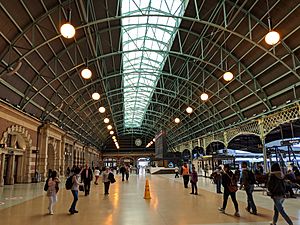
Sydney has Australia's largest public transport network. 67% of residents can access good public transport. Sydney's train network started in 1855. It grew with European settlement. Electric trains were introduced in 1926. By 1991, all lines in Sydney were electric.
The train network uses Opal cards. These are reusable cards that calculate fares. Central station, built in 1906, is the largest and busiest train station. It is the main hub for the city's rail network. Sydney Trains is the suburban rail service. It serves 168 stations. It had 302 million passenger journeys in 2023–24.
Metro
The Sydney Metro is a driverless rapid transit network. It is separate from the suburban train network. It connects at major stations. Currently, one line runs from Tallawong in the north-west to the city and Sydenham. This line will extend to Bankstown in 2025. A new line through the inner west to Parramatta is planned for 2030. It currently serves 21 stations. A line to serve the greater west is planned for 2026. It will include a station for the second international airport. Sydney Metro trains run more often than suburban trains. This plan aims to increase Sydney's public transport capacity by 60%.
Light Rail
Sydney once had one of the largest tram networks in the British Empire. It covered 291 kilometers (181 miles). Buses became more popular than trams. The tram network closed, with the last tram running in 1961.
In 1997, the Inner West Light Rail opened. It ran between Central station and Wentworth Park. It used an old freight line. It was extended to Lilyfield in 2000 and Dulwich Hill in 2014. It connects the Inner West and Darling Harbour to Central station. It had 9.1 million journeys in 2016–17. A second line, the CBD and South East Light Rail, opened in 2019–2020. It serves the CBD and Eastern Suburbs. A light rail line for Parramatta opened in 2024.
Buses
Bus services are run by private companies under contract to Transport for NSW. Opal cards work on bus routes. Nearly 225 million bus trips were recorded. NightRide is a nightly bus service. It runs between midnight and 5 am.
Ferries

When the Sydney Harbour Bridge opened in 1932, the city's ferry service was the largest in the world. The number of passengers dropped from 37 million in 1945 to 11 million in 1963. But it has recovered recently. From its main hub at Circular Quay, the ferry network goes from Manly to Parramatta. Ferries are operated by Transdev Sydney Ferries. They run on 10 routes across the harbour and Parramatta River.
Airports
Sydney Airport, also called "Sydney Kingsford-Smith Airport," is in Mascot. It serves 46 international and 23 domestic places. It is Australia's busiest airport. It handled 37.9 million passengers in 2013. A second airport, Western Sydney Airport, is being built at Badgerys Creek. It will open in late 2026. It will cost $2.5 billion. This airport will not have a curfew, unlike Sydney Kingsford-Smith Airport. Bankstown Airport is Sydney's second busiest airport. It is used for general aviation and charter flights. Other airports include Camden Airport. Port Botany has become the city's main shipping port. Cruise ship terminals are at Sydney Cove and White Bay.
Utilities
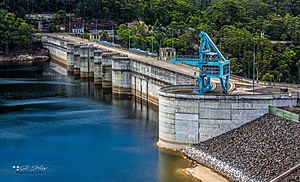
Getting enough fresh water was hard in early colonial times. The Tank Stream supplied water, but it became polluted. The Botany Swamps Scheme in the mid-1800s built wells and dams for Sydney's growing population.
The Upper Nepean Scheme started in 1886. It brings water 100 kilometers (62 miles) from the Nepean, Cataract, and Cordeaux rivers. It still provides about 15% of Sydney's water. Dams were built on these rivers between 1907 and 1935. In 1977, the Shoalhaven Scheme added more dams.
The state-owned company WaterNSW manages eleven major dams. These include Warragamba, one of the world's largest dams for domestic water supply. Water is collected from five areas covering 16,000 square kilometers (6,200 square miles). Total storage is 2.6 teraliters (0.62 cubic miles). The Sydney Desalination Plant started in 2010. WaterNSW supplies water to Sydney Water. This company handles water distribution, sewerage, and stormwater.
Sydney's electricity is managed by Ausgrid and Endeavour Energy. Their networks have over 815,000 poles and 83,000 kilometers (52,000 miles) of cables. Submarine communications cable systems connect Sydney to other countries. These include the Australia–Japan Cable and the Southern Cross Cable.
Environmental Issues and Pollution Reduction
Air Quality
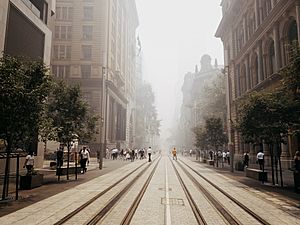
Climate change and pollution are big issues for Australia. Sydney has been criticized for not focusing enough on reducing pollution. The Metropolitan Air Quality Scheme (MAQS) helped understand pollution causes in Sydney. This allowed the government to respond better.
The 2019–20 Australian bushfire season greatly affected outer Sydney. It made the air quality very bad. A smoky haze stayed for days. The air quality was 11 times the dangerous level on some days. It was worse than New Delhi's. It was compared to "smoking 32 cigarettes" by a scientist. Sydney is surrounded by bushland. So, bushfires can create a "ring of fire" around the region.
The City of Sydney became the first council in Australia to be certified as carbon-neutral in 2008. The city has cut its carbon emissions by 6% since 2007. It has reduced carbon emissions from city buildings by up to 20% since 2006. The Sustainable Sydney 2030 program aims to cut energy use in homes and offices by 30%. This has saved $30 million a year in energy bills. Solar panels on many CBD buildings reduce carbon pollution by about 3,000 tonnes a year.
The city also has an "urban forest growth strategy." It aims to increase tree coverage. This means planting trees with thick leaves to provide cleaner air and moisture. This helps lower city temperatures. Sydney is also a leader in building green office buildings. All new building plans must be energy-efficient. The One Central Park development, finished in 2013, is an example.
Car Use
Australian cities are very dependent on cars. But Sydney's car dependency is the lowest among Australia's major cities, at 66%. Sydney also has the highest use of public transport in an Australian city, at 27%. This is similar to New York City and Berlin. Despite this, Sydney has a low level of public transport services. Its low-density layout and large urban sprawl increase car dependency.
Strategies have been put in place to reduce car pollution. These include encouraging public transport and building more high-density housing. Sydney also has a fleet of 10 new electric cars. This is the largest order of these pollution-free vehicles in Australia. Electric cars do not produce carbon monoxide and nitrous oxide. These gases contribute to climate change. Cycling trips increased by 113% in Sydney's inner-city from 2010 to 2015. Transport developments in the north-west and east of the city encourage using public transport.
Sister Cities
Sydney has sister city relationships with:
- San Francisco, United States of America
- Wellington, New Zealand
- Florence, Italy
- Nagoya, Japan
- Portsmouth, United Kingdom
- Guangzhou, China
See also
 In Spanish: Sídney para niños
In Spanish: Sídney para niños
- List of museums in Sydney
- List of people from Sydney
- List of public art in the City of Sydney
- List of songs about Sydney
- Outline of Sydney


